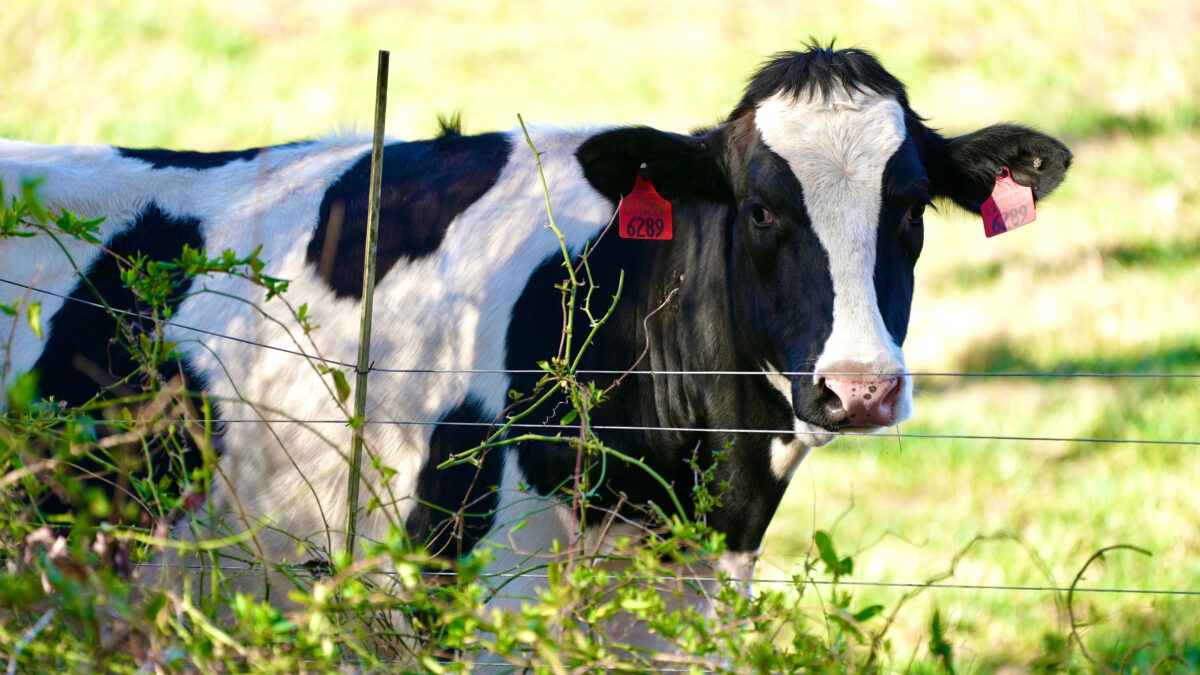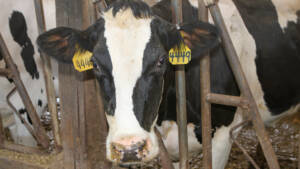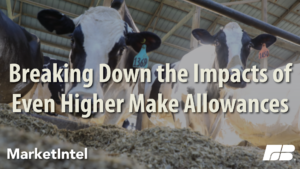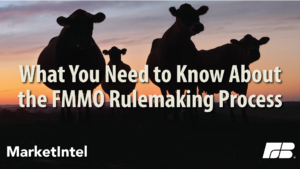American Farm Bureau Federation Chief Economist Roger Cryan presented the testimony below on behalf of AFBF and its membership at the ongoing Federal Milk Marketing Order Pricing Formula hearing.
The testimony focuses on removing Class I and Class II milk from the advanced pricing formula used by dairy processors when calculating the price paid to farmers for their milk. Class I milk is used for beverages while Class II milk is used for foods like ice cream, cottage cheese and sour cream.
According to AFBF data presented at the hearing, advanced pricing has disrupted the orderly marketing of milk and led to unfair marketing conditions for dairy farmers. This disruption is caused when the price of other classes of milk rises above the announced advanced price of Class I and Class II milk. A full explanation of advanced pricing is available via Market Intel.
AFBF has previously testified
on adding 640-pound cheddar cheese blocks and unsalted butter to the price survey used in Class price calculations, in support of member policy to include more products in the price calculations. AFBF also supports several proposals by the National Milk Producers Federation, which would increase Class I prices, drop barrel cheese from the Class III price formula, and return to the “higher-of” Class I formula.
Below are excerpts from the testimony, which can be read in full here.
A fundamental focus of AFBF’s proposals is the reduction or elimination of negative producer price differentials and the de-pooling they cause. We believe that an orderly pool is the key to orderly marketing and ensuring Federal Milk Marketing Orders continue to benefit farmers, cooperatives, processors, and consumers. The key to an orderly pool, in turn, is, above all, the proper alignment of the four Class prices.
This statement covers AFBF proposal 18 under category four.
Proposal 18:AFBF proposes to end the advanced pricing of Class II skim milk and components and Class I milk and components
In AFBF proposal 18, the Class II skim milk price would be equal to the Class IV skim milk price plus the Class II differential. The Class II nonfat solids price would be equal to the Class IV nonfat solids price plus one-hundredth of the Class II differential. The Class I skim milk price would be the higher of the Class III or Class IV skim milk price plus the Class I differential. And the Class I butterfat price would be equal to the butterfat price plus one-hundredth of the Class I differential.
Under classified dairy pricing, handlers participating in an order have an obligation to the pooling function of federal orders based on how the milk is used (the Class price). In seven of the 11 federal orders dairy farmers are paid based on the component content of their milk via multiple component pricing. In this process the producer value of milk is determined monthly based on the cheese milk (Class III) component levels of fat, protein, and other solids. The difference between the total pooled revenue from what handlers pay for their allocated Class price values and the component value worth of producer’s milk is denoted as the producer price differential. When the component value of milk in the pool is higher than revenue pooled from paid Class prices, deductions are applied to farmers’ checks in the form of a negative producer price differential to represent the gap in pool value. Dairy farmers became accustomed to negative PPDs during 2020 and 2021 with average all-market PPDs reaching over -$7 per hundredweight – showing up as a massive deduction on milk checks.
Furthermore, the testimony describes the issue of when milk prices are announced:
Currently, the classified prices for each month are announced at two different times. First, the advanced prices are announced by the 23rd day of the preceding month. For example, September’s advanced prices are announced on or before August 23. Advanced minimum prices are announced for Class I, Class I skim, Class I butterfat, and Class II skim. By the fifth day of the following month, the Class II, Class II butterfat, Class III, Class III skim, Class III butterfat, Class IV, Class IV skim, and Class IV butterfat prices are announced. These prices for September are announced on or before October 5. This arrangement creates a long lag between when the advanced prices and current prices are announced for that same month and means that the advanced prices (Class II skim milk and components and Class I skim milk and butterfat) can be based on weekly data that is 25 to 40 days older, on average, than the basis for the “current” prices (Class II butterfat and all Class III and IV prices).
This means when market prices rally, announced (final) prices can be much higher than advanced prices, leading to low and negative PPDs. This creates an incentive to de-pool milk from the order to benefit from the non-pooled value of the recently elevated prices (without sharing that value with the pool), which further depresses the PPD, and undermines the FMMO principle of uniform pricing.
… Dairy farmers have had to deal with wide and rapid spreads in prices that have contributed to income uncertainty and disruptions in their ability to manage risk. Over the past 20 years the percentage of de-pooled milk has increased. Based on data from USDA, between 2007 and 2012 the average monthly percent of eligible milk that was de-pooled across all orders was 5.7%; between 2013 and 2018 this percentage increased to 9.5%. Between 2018 and 2023, this figure nearly doubled to an average of 18.9% of eligible milk being de-pooled each month. Handlers are de-pooling milk at higher volumes more frequently.
The testimony concludes with a summary:
AFBF believes that disorderly marketing conditions are present when producers do not receive uniform prices because of frequent de-pooling. AFBF also believes the current system of advanced pricing contributes to the frequency and magnitude of de-pooling. Given the growing number of resources for data and market information, AFBF proposes a structure of announcing Class prices at the same time.
Full AFBF testimony on advanced pricing as submitted to the hearing, including reference sources, charts and updated statute language, is available here. An explanation of the four AFBF proposals accepted for consideration is available here. For more information on all nine AFBF proposals, including those rejected by USDA, read Market Intel.




